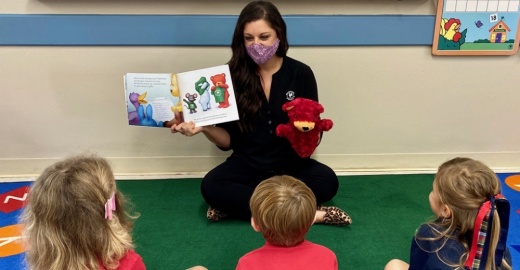In August, the Austin metropolitan area had 100 more workers overall than in August 2020, furthering the metro’s economic recovery. But many small private child care providers are still recovering with enrollment and staffing levels since the pandemic first impacted the industry in April 2020, said Diane Tackett, chief operating officer of Workforce Solutions Rural Capital Area. According to the most recent data from Texas Labor Analysis, there were 1,451 fewer child care workers employed in the first quarter of 2021 compared to the first quarter of 2020.
When the pandemic struck, many parents lost their jobs or transitioned to working from home, creating a struggle for the industry to connect with its main revenue source. To climb back up, child care providers are raising tuition to pay competitive living wages, Tackett said.
“Even prior to the pandemic, high-quality early learning was expensive,” Tackett said. “In some areas the cost can be comparable to annual tuition for a four-year degree program.”
As fewer parents were able to pay for child care, the child-to-teacher ratio within classrooms became more unbalanced as child care centers were unable to pay as many staff, Tackett said. The ideal child-to-teacher ratio ensures each child gets enough individual attention, according to a ChildCare study. The exact ratio depends on the age of children in a classroom and ranges from one adult per four children to one adult per 12 children, according to the study.
The child care industry was struggling with how to balance this ratio even before the pandemic. House Bill 3, which Gov. Greg Abbott signed in 2019, expanded prekindergarten for eligible 4-year-olds to full days. Since then, more 4-year-olds have enrolled in preschools rather than child care centers, Tackett said.
Combined with this legislation and the added struggles of an ongoing pandemic, staffing issues are a consistent issue with the industry, Tackett said.
“Because they are typically private nonprofit small businesses, the skills they need for workers is the same as what school districts and other larger organizations need, so they are competing for the same talent pool,” Tackett said.
Stacy Ham, owner and president of Little Acorn Academy in Cedar Park, said her child care center cannot accept the 40 kids on their enrollment waitlist until she is able to hire more staff.
“Parents do want to go to work, and they do want their kids to go to day care, but we don’t have the staff to accommodate them,” Ham said. “We set two to three interview appointments a day, and I’ve had one interview the last month actually show up.”
To market and attract new employees she has spent $3,000 on job posting ads and has been able to hire one person, Ham said. She has four vacancies left. Little Acorn Academy is serving around 67 children and has the capacity to serve 140.
The center received $100,000 in federal aid money within the last month in one lump sum check, she said. Ham plans to use that money to pay their staff higher wages and attract more employees, but Ham said that effort will only be able to last for one or two more years.
However, governmental financial aid will only go so far to help an industry that has already been on shaky ground before the pandemic, said Ed Bradley, chief operating officer of E&A Partners LLC and Kyle’s Bright Beginnings. Kyle’s Bright Beginnings is also facing a staff shortage preventing it from accepting 30 kids on its waitlist.
“A Band-Aid here and a Band-Aid there isn’t what the industry needs,” Bradley said. “There needs to be a permanent resolution for how to fund early childhood education. However, there’s way more awareness than there was a few years ago.”
While politicians and businesses figure out what that permanent solution is, Alice Bradley, CEO of E&A Partners LLC, said being a small private business in the industry is a challenge.
“We can’t compete with the chains that offer their employees higher wages and benefits,” Alice said. “We just can’t do that, and we are losing some good ones to those who offer that.”
While the industry is battling to get back on its feet, parents such as Sadie Aguero, a mother of two, continue to benefit from the service, Aguero said. After six months of staying at home during the pandemic, she took a job as a health care worker and found a child care center just before her start date.
Because she had never used a child care provider before, Aguero said she felt an added pressure from the pandemic to find a provider that offered more sanitation processes. Even though she feels safe with her daughter getting the care she needs, she still worries about what can happen in the future.
“What happens if someone tests positive at the day care?” Aguero said. “What are we going to do if we have to quarantine? I can’t take two weeks off.”
Going forward, Alice and Ed Bradley said for the industry to get the help it needs, politicians, businesses and families need to understand how important early childhood education through child care is.
“Child care is more important to your overall development and learning ability than a year at a public university,” Ed Bradley said. “When children have access to good high-quality early childhood education, their outcomes in their lives are much better and there is a generational impact, not to mention the economic return on investment from these children getting a better start.”
Ensuring child care services for essential workers, the Texas Workforce Commission announced Sept. 22 the Service Industry Recovery program in addition to its existing child care subsidy program. The $500 million program is intended to help low-income parents in the service industry by providing 12 months of free child care, according to the press release. The program is funded by a Child Care Development Block Grant through multiple federal COVID-19 relief funds. All 28 workforce development boards have received funding from the SIR program. To find a local Workforce Solutions Office that can help, click here.
“For many Texans, lack of access to affordable, quality child care is sometimes the biggest roadblock to getting a job,” TEA Commissioner Representing Labor Julian Alvarez said in the press release. “Workers should not have to choose between their families and their jobs. They need and want to do both, and this program helps them do that.”





